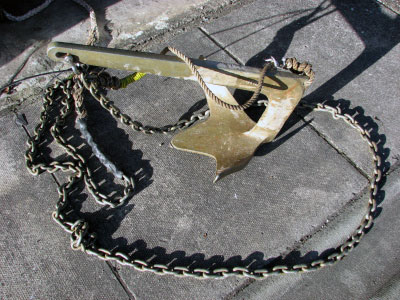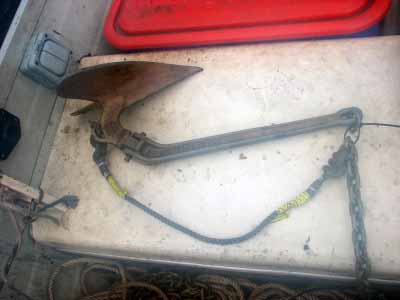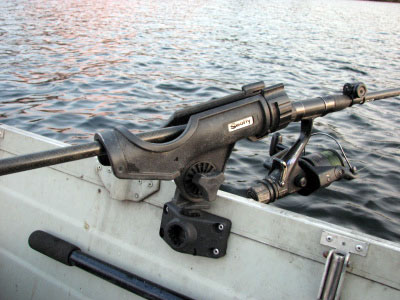Anchoring
If you’re fishing for coarse fish, the inability to anchor up properly is a certain way to ruin your day’s sport. Anchoring is one of those things that people take so much for granted but like everything else, there’s a right way and a wrong way. Choosing the right anchor for your needs is the first thing. There is a wide range of anchors available and each is most suitable for a particular application.
Most people would be well familiar with the grab type of anchor, which are available at a fairly modest price from any chandler’s. As well as being cheap to buy they have the advantage of being collapsible so they are easy to transport and store but they are fairly limited in their application. A grab anchor will work well over a rocky bottom and reasonably over sand. They are very poor in silt however and are quite prone to snagging up. I’ve never lost an anchor on a snag but I’ve come closer with a grab anchor than with anything else. If you decide on a grab anchor then I would suggest you get a heavy one, maybe ten pounds. You’ll definitely need to attach a good heavy length of chain to it too. This both adds weight and provides a shock absorber, which prevents sudden swings of the boat from snatching the anchor off its purchase. On the whole I don’t rely on grab anchors much. They are okay to use as a downwind anchor that is not going to come under much strain but are just not good enough for a main anchor.
 |
|
“My 10kg Bruce anchor, also called a claw anchor.” |
My two main types of anchor are the Bruce and the plough. Both are suitable for use over any kind of lakebed with the Bruce being particularly effective in soft silt, something I encounter a lot. The Bruce anchor, which I use upwind off the bow of the boat, is the larger of the two at 10kg and to be honest it is a little too large, though it never moves even in a strong blow. The plough, which I use off the stern, weighs 5kg. The two anchors each have a 15ft length of heavy chain attached.
Sometimes, if I’m fishing on a river or a small stillwater, or if there isn’t much wind, I’ll rely on mudweights rather than anchors. The mudweight, as its name suggests, is best suited to a muddy bottom. Sash weights make quite effective mudweights, dropped vertically into the mud they will bury deep in it and will hold a boat even in quite a strong wind. My mudweights are shorter and squatter than a sash weight and have an important feature that really makes a difference – a concave base. This concave end acts like a sucker in the mud, holding the weight in place due to suction and preventing boat movement very effectively. I do not use chain on my mudweights – at 20lbs the damn things are heavy enough!
How To Do It
Setting the anchors properly on a big water is more complicated than you might think. Simply dropping a single anchor to the bottom on a short length of rope isn’t good enough to enable you to fish effectively. The boat will swing wildly in even a modest breeze and if you’re trying to fish over a tightly baited area or on the edge of a steep drop-off, you will find it hard to keep your bait in the desired spot. You can prevent this however by using two anchors, both of which are tied to long ropes. My ropes are 150ft long but you may not need so much rope depending on the depth of water you intend to fish. You will need a length of rope at least three times the depth and since I regularly fish in very deep water, I need long ropes.
The way to do it is as follows:
Find your desired fishing spot and motor a little way upwind (or upstream) of it, stop the boat and drop your main anchor here. Put the engine into reverse and slowly maneuver the boat downwind from this anchor until there is only a little rope left (make sure you’ve tied the end to something) and, still in reverse, open the throttle a little. This will dig the anchor into the lakebed and help prevent it from moving when the wind gets up. Now put the engine into neutral, drop the stern anchor and pull up on the bow anchor line, allowing the other rope to spill off the stern until the boat is positioned directly above the front anchor. Now put the engine into forward gear and open the throttle a little to dig the back anchor in as you did the front. Now allow some slack at the front and let the boat drift back until you are mid-way between the two anchors before tying off the rope on the front anchor. Now pull on the stern anchor until both ropes become taut and tie off the other end of the rope at the stern. You should now have your boat locked firmly between the two anchors with the two ends of the rope running off at steep angles under tension. Anchored like this, the boat will swing very little, thus allowing you to fish tight to whatever underwater feature you are after.
One other little touch which comes with experience though; if you have managed to anchor the boat up at a slight angle to the wind rather than facing directly into it you will find that the boat does not swing at all but stays rock steady! Having the ropes run off at an angle like this rather than having them drop straight down has another very important advantage. If a hooked fish runs under the boat it is an easy matter to thread the rod under the rope in the same direction. This actually happened to me whist playing one of my biggest ever pike and I was ever so glad that I’d learned this trick from my old mate Grant Everson.
How To Undo It
While on the subject of anchoring, I really need to tell you how to bring the anchors back in again. The stern anchor is easy to bring up but when fishing from a boat with a cabin or cuddy it can be a little difficult to retrieve the front anchor. The rope on this anchor ought to run through a bow cleat or preferably a bow roller so that it keeps the bow into the wind. The chain on the rope tends to inhibit retrieval through the bow roller however and another method of retrieval is needed – enter the lazy line.
The lazy line is a short piece of cord with one end tied to an accessible point in the boat and a large dog-lead clip on the free end. This clip stays clipped on the rope in between the anchor and the bow roller. When you want to retrieve the bow anchor, you should pull up to it on the rope until the anchor is positioned underneath the boat. Now pull on the lazy line while allowing the main rope to slip through your fingers. When the clip and rope appear, stop pulling on the lazy line and simply pull the anchor off the bottom using the main rope. Be sure to wash the mud off before you bring it on board – your boat and tackle will soon get in a nice mess if you don’t.
I carry my ropes and anchors in a trug, which is a kind of floppy bucket used a lot by gardeners. These things are very tough and there is no danger of the handles breaking no matter how heavy the anchors. Using one of these both keeps the anchors all together, making them easily transportable and stops the mud from the anchors from getting all over the boat.
 |
|
“Here you see the weak link attachment on my plough anchor” |
Weak Links
Getting an anchor snagged can be both dangerous and costly. You really wouldn’t want to be out on a big lake in a blow with a £50 anchor jammed in rocks deep beneath you and your only option being to let it go but you can prevent this from ever happening by having a weak link in your setup. Close inspection of your anchor, whatever its type, will reveal a second eye at its base and it’s here that the main attachment should be. You can attach the end of your chain here using a shackle if you want to but I prefer to use a short length of rope running from the end of the chain down to the base of the anchor. I then attach the chain to the eye at the top of the anchor with my weak link, invariably a large cable tie.
When my anchors get stuck, which happens from time to time, then by positioning the boat directly above the anchor and pulling hard, I can snap the cable tie. The pull on the anchor then shifts to its base and this pulls it straight out of the snag. It never fails!
Other Boaters – Things to Bear in Mind
Lakes and rivers are normally quite a lot quieter than roads but traffic does occur in some places. There are some rules that need to be observed but commonsense is your best guide. When approaching another boat you should always pass on the right. Be wary however of sailing craft, especially windsurfers as they may not have the maneuverability of a powered boat and should be given a wider berth.
Please remember the wash your boat might create. This can be a nuisance to bank anglers and a hazard to others in small boats. This is something that water skiers often seem not to care about and you will, at times find yourself cursing their arrogance.
Rowers can be a real hazard as they are in the unfortunate position of traveling backwards all of the time. Rowers often fail to look where they are going and will crash into a moored boat if they are not alerted to the danger. You should have some means of warning others of your presence – if only a loud shout!
If you are using your boat at night it is best to carry navigation lights. These are red and green lights that fit either side of the boat, along with a white beacon if it is anchored. Many waters and waterways insist on the use of navigation lights at night.
Little Luxuries
Make no mistake; there really is no limit to the amount of time and money you can spend on a boat but you will probably want to draw the line at a few small items which will make your boat fishing that little bit more comfortable.
The bow roller is something I’ve already mentioned, this will cost around £25. You should also install a few cleats at strategic points about the boat. These should be of the locking type which allow you to tie off a rope quickly either by turning it around the cleat and pulling tight or by slotting it into spring-loaded jaws. I prefer the former although I have both types fitted.
If your boat doesn’t have a fitted floor, duck boarding is well worth considering. It will help keep your tackle and your feet dry and can be knocked up in an afternoon at minimal cost. I’ve fitted an aluminium floor to my boat, it was a lot of work and fairly costly but it’s a real boon and I don’t regret the many hours work I invested in it.
Fit a platform for your battery at the bow end of your boat, or better still a battery box. This will keep it well away from the petrol tank, thus avoiding the hazard of mixing electrics with fuel and the weight will help keep the bow of the boat down while you are motoring – this can make a big difference to your speed and fuel consumption. I have a strap fastened to my battery box and use this to prevent the battery from being flung about in bad weather. A pair of quick release clips like those used by caravanners can be used to connect the battery to the boat’s electrics. These cost about six pounds and are available from any camping or caravanning shop.
Once you have electrics installed there is so much more that you can do. A bilge pump, for instance, is a real boon. This can easily be fitted under the boards and it means that the boat can be emptied of rainwater at the flick of a switch. Other electrical items I find useful are an interior light and a pair of 12v sockets which allow me to use a variety of plug-in items like hand lamps. I also have a bow-mounted floodlight, which helps when motoring back to the slipway at the end of the day. Hopefully you’ll have spent that little bit extra on your outboard and bought one that charges your battery back up when motoring.
Ready to Go
There are just a few more items which will make your fishing that bit more enjoyable. Rods are a pain in a boat but there’s not really any getting away from the fact that you are going to need them! It’s a good idea to install a rack if you have room in your boat. This can be used to keep the rods tidy while in transit. Take care however, for if the rack has the rods pointing skywards, low bridges and low power lines can provide an unexpected and most unpleasant surprise!
 |
|
“Scotty rod holders are strong and secure.” |
When in use, the rods should be held in boat rod rests. Cheap boat rod rests are ok if you only want to fish baits but if you’re likely to do any trolling, especially with lures, then you’ll need something more substantial. A vicious strike from a big fish will bend a poor quality rest quite easily and you risk losing your rod. Scotty rod holders are the ones I have fixed to my boat and they are very good. If you want a rod holder that you can transport and use on hire boats the Downeast are the ones to buy.
Be sure to put down some soft matting before you venture out. This will help deaden the noise of heavy footfalls and provides a much kinder surface to unhook fish on than hard boards. Many people like to use old carpet for this purpose but be sure to wet it before use or it will strip the slime from any fish you catch. I prefer to use a large (4ft) unhooking mat which can be removed from the boat at the end of the day and dried out.
A bailer will come in handy (though not necessarily for bailing) as does a bucket to store excess rope in.
And before you set out – don’t forget those lifejackets!
Now you really are ready to go. Next instalment, I’ll attempt to tell you just how having a boat gives you the edge and why it is that the majority of my best fish have been caught while fishing from a boat despite the fact that most of my fishing is from the bank.
Eric Edwards










